#the atlantic council
Text
« In 1999, exactly a quarter of a century ago, Poland was invited to join NATO and the transatlantic family.
Twenty-five years later, not least because of the security guarantees that NATO provided us, we have become the fifth largest economy of the European Union, and the main buyer of US military equipment as I’ve already mentioned.
Victorious Ukraine may follow a similar path.
[ … ]
Ladies and gentlemen, whether we want it or not, Putin’s decision to start the biggest war in Europe since the defeat of Nazi Germany has already changed the course of history. It is up to us to decide if we want to shape that course ourselves, or let it be shaped by others—in Moscow, Tehran, or Beijing.
Helping Ukraine by defeating Putin is the right thing to do in the broadest sense of the word.
It is morally sound, strategically wise, militarily justified, and economically beneficial.
It outweighs politics. It transcends partisanship.
Now is the moment to act. Let’s get this done. »
— Foreign Minister Radosław "Radek" Sikorski of Poland speaking Monday at the Atlantic Council.
You can see his address and the following discussion in this vid.
youtube
In response to a question from the audience, Pan Sikorski gave this insight on Putin's thinking regarding the war:
[T]he trouble is that Putin doesn’t have an incentive to make peace. He’s already indicted at the Hague for stealing Ukrainian children. And he probably thinks that he—that it’s better for him to have a bad war than an unsatisfactory peace.
The only way to end the war is to make it way bad for Putin to continue it.
Putin is counting on the notoriously short American attention span while manipulating US politics through his vassal Donald Trump. We need to understand that wars don't go away just because Americans get bored with them.
A defeat in Ukraine for ethno-nationalist Putin and his mafia fascist régime is a victory for international liberal democracy.
#invasion of ukraine#the atlantic council#radosław sikorski#poland#polska#liberal democracy#nato#UkraineAidNow#russia's war of aggression#russian imperialism#vladimir putin#ethno-nationalism#НАТО#русский империализм#агрессивная война россии#владимир путин#путин хуйло#добей путина#союз постсоветских клептократических ватников#руки прочь от украины!#геть з україни#польща#радослав сікорський#вторгнення оркостану в україну#деокупація#слава україні!#героям слава!
39 notes
·
View notes
Text
"I SHALL CURSE POSEIDONS LAND WITH THE POWER OF ZUES!!!"
(i am throwing car batteries into the ocean)
#wizard#wizard posting#wizard council#car battery#atlantic ocean#kratos#god of war#where else am i going to put them
28 notes
·
View notes
Text
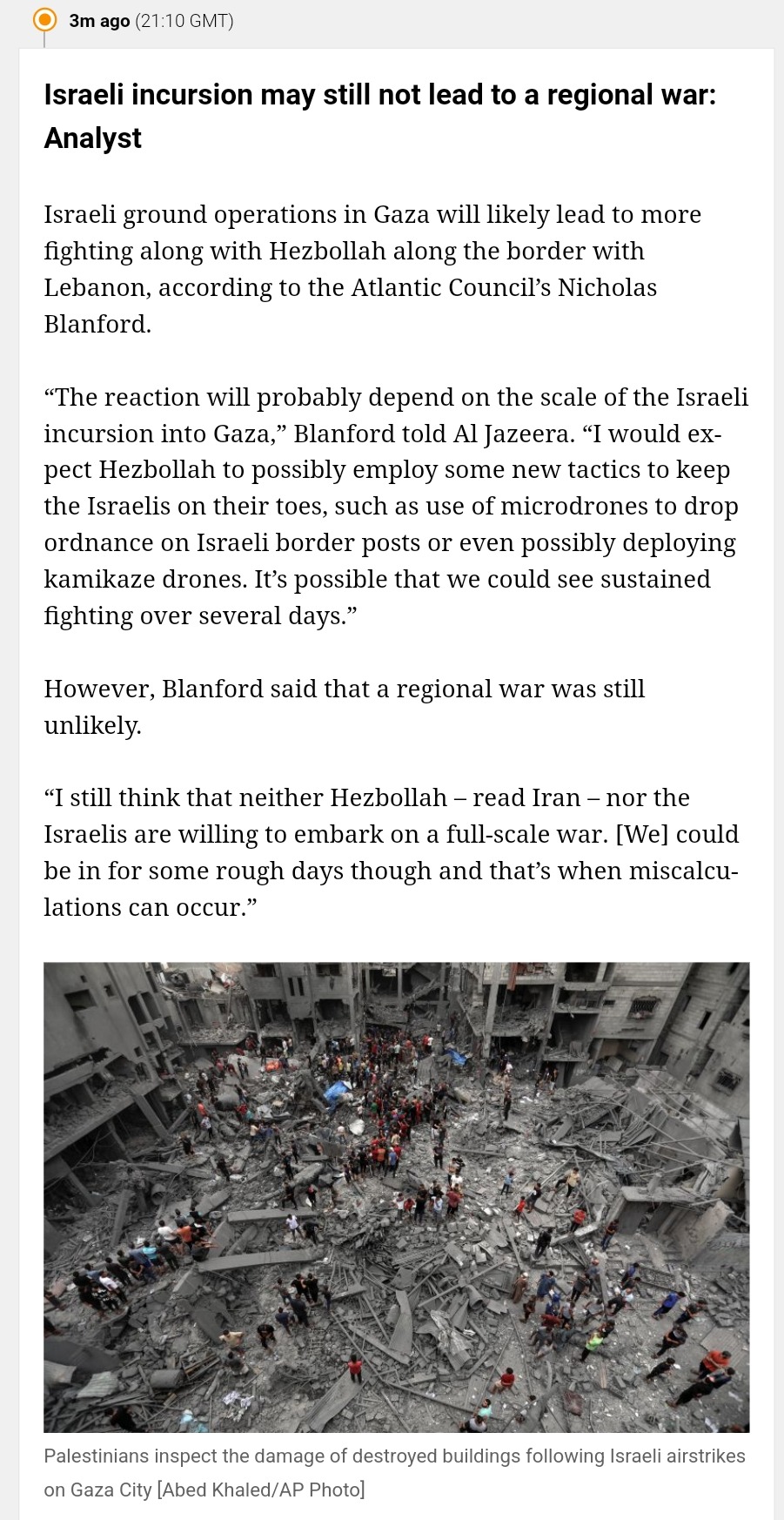
Analysis from Nicholas Blanford on why Apartheid Israel's invasion of Gaza may still not lead to a regional war
#free gaza#free palestine#gaza strip#irish solidarity with palestine#palestine#gaza#news on gaza#al jazeera#boycott israel#israel#Nicholas Blanford#Atlantic Council#Analysis#lebanon#hezbollah
4 notes
·
View notes
Text
Analysis: The China-Russia Axis Takes Shape
The bond has been decades in the making, but Russia’s war in Ukraine has tightened their embrace.
— September 11, 2023 | By Bonny Lin | Foreign Policy

Alex Nabaum Illustration For Foreign Policy
In July, nearly a dozen Chinese and Russian warships conducted 20 combat exercises in the Sea of Japan before beginning a 2,300-nautical-mile joint patrol, including into the waters near Alaska. These two operations, according to the Chinese defense ministry, “reflect the level of the strategic mutual trust” between the two countries and their militaries.
The increasingly close relationship between China and Russia has been decades in the making, but Russia’s invasion of Ukraine has tightened their embrace. Both countries made a clear strategic choice to prioritize relations with each other, given what they perceive as a common threat from the U.S.-led West. The deepening of bilateral ties is accompanied by a joint push for global realignment as the two countries use non-Western multilateral institutions—such as the BRICS forum and the Shanghai Cooperation Organisation (SCO)—to expand their influence in the developing world. Although neither Beijing nor Moscow currently has plans to establish a formal military alliance, major shocks, such as a Sino-U.S. conflict over Taiwan, could yet bring it about.
The cover of Foreign Policy's fall 2023 print magazine shows a jack made up of joined hands lifting up the world. Cover text reads: The Alliances That Matter Now: Multilateralism is at a dead end, but powerful blocs are getting things done."
China and Russia’s push for better relations began after the end of the Cold War. Moscow became frustrated with its loss of influence and status, and Beijing saw itself as the victim of Western sanctions after its forceful crackdown of the Tiananmen Square protests in 1989. In the 1990s and 2000s, the two countries upgraded relations, settled their disputed borders, and deepened their arms sales. Russia became the dominant supplier of advanced weapons to China.
When Xi Jinping assumed power in 2012, China was already Russia’s largest trading partner, and the two countries regularly engaged in military exercises. They advocated for each other in international forums; in parallel, they founded the SCO and BRICS grouping to deepen cooperation with neighbors and major developing countries.
When the two countries upgraded their relations again in 2019, the strategic drivers for much closer relations were already present. Russia’s annexation of Crimea in 2014 damaged its relations with the West and led to a first set of economic sanctions. Similarly, Washington identified Beijing as its most important long-term challenge, redirected military resources to the Pacific, and launched a trade war against Chinese companies. Moscow and Beijing were deeply suspicious of what they saw as Western support for the color revolutions in various countries and worried that they might be targets as well. Just as China refused to condemn Russian military actions in Chechnya, Georgia, Syria, and Ukraine, Russia fully backed Chinese positions on Taiwan, Hong Kong, Tibet, and Xinjiang. The Kremlin also demonstrated tacit support for Chinese territorial claims against its neighbors in the South China Sea and East China Sea.
Since launching its war in Ukraine, Russia has become China’s fastest-growing trading partner. Visiting Moscow in March, Xi declared that deepening ties to Russia was a “strategic choice” that China had made. Even the mutiny in June by Wagner Group leader Yevgeny Prigozhin that took his mercenary army almost to the gates of Moscow did not change China’s overall position toward Russia, though Beijing has embraced tactical adjustments to “de-risk” its dependency on Russian President Vladimir Putin.
Building on their strong relationship, Xi and Putin released a joint statement in February 2022 announcing a “No Limits” strategic partnership between the two countries. The statement expressed a litany of grievances against the United States, while Chinese state media hailed a “new era” of international relations not defined by Washington. Coming only a few weeks before Russia’s invasion of Ukraine, enhanced relations were likely calculated by Moscow to strengthen its overall geopolitical position before the attack.
It’s not clear how much prior detailed knowledge Xi had about Putin’s plans to launch a full-scale war, but their relationship endured the test. If anything, the Western response to Russia’s war reinforced China’s worst fears, further pushing it to align with Russia. Beijing viewed Russian security concerns about NATO expansion as legitimate and expected the West to address them as it sought a way to prevent or stop the war. Instead, the United States, the European Union, and their partners armed Ukraine and tried to paralyze Russia with unprecedented sanctions. Naturally, this has amplified concerns in Beijing that Washington and its allies could be similarly unaccommodating toward Chinese designs on Taiwan.
Against the background of increased mutual threat perceptions, both sides are boosting ties with like-minded countries. On one side, this includes a reenergized, expanded NATO and its growing linkages to the Indo-Pacific, as well as an invigoration of Washington’s bilateral, trilateral, and minilateral arrangements in Asia. Developed Western democracies—with the G-7 in the lead—are also exploring how their experience deterring and sanctioning Russia could be leveraged against China in potential future contingencies.
On the other side, Xi envisions the China-Russia partnership as the foundation for shaping “the global landscape and the future of humanity.” Both countries recognize that while the leading democracies are relatively united, many countries in the global south remain reluctant to align with either the West or China and Russia. In Xi and Putin’s view, winning support in the global south is key to pushing back against what they consider U.S. hegemony.

Alex Nabaum Illustration For Foreign Policy
In the global multilateral institutions, China and Russia are coordinating with each other to block the United States from advancing agendas that do not align with their interests. The U.N. Security Council is often paralyzed by their veto powers, while other institutions have turned into battlegrounds for seeking influence. Beijing and Moscow view the G-20, where their joint weight is relatively greater, as a key forum for cooperation.
But the most promising venues are BRICS and the SCO, established to exclude the developed West and anchor joint Chinese-Russian efforts to reshape the international system. Both are set up for expansion—in terms of scope, membership, and other partnerships. They are the primary means for China and Russia to create a web of influence that increasingly ties strategically important countries to both powers.
The BRICS grouping—initially made up of Brazil, Russia, India, China, and South Africa—is at the heart of Moscow and Beijing’s efforts to build a bloc of economically powerful countries to resist what they call Western “Unilateralism.” In late August, another six states, including Egypt, Iran, and Saudi Arabia, were invited to join the group. With their growing economic power, the BRICS countries are pushing for cooperation on a range of issues, including ways to reduce the dominance of the U.S. dollar and stabilize global supply chains against Western calls for “Decoupling” and “De-risking.” Dozens of other countries have expressed interest in joining BRICS.
The SCO, in contrast, is a Eurasian grouping of Russia, China, and their friends. With the exception of India, all are members of China’s Belt and Road Initiative. The accession of Iran in July and Belarus’s membership application put the SCO on course to bring China’s and Russia’s closest and strongest military partners under one umbrella. If the SCO substantially deepens security cooperation, it could grow into a counterweight against U.S.-led Coalitions.
Both BRICS and the SCO, however, operate by consensus, and it will take time to transform both groups into cohesive, powerful geopolitical actors that can function like the G-7 or NATO. The presence of India in both groups will make it difficult for China and Russia to turn either into a staunchly anti-Western outfit. The diversity of members—which include democracies and autocracies with vastly different cultures—means that China and Russia will have to work hard to ensure significant influence over each organization and its individual members.
What’s next? Continued Sino-Russian convergence is the most likely course. But that is not set in stone—and progress can be accelerated, slowed, or reversed. Absent external shocks, Beijing and Moscow may not need to significantly upgrade their relationship from its current trajectory. Xi and Putin share similar views of a hostile West and recognize the strategic advantages of closer alignment. But they remain wary of each other, with neither wanting to be responsible for or subordinate to the other.
Major changes or shocks, however, could drive them closer at a faster pace. Should Russia suffer a devastating military setback in Ukraine that risks the collapse of Putin’s regime, China might reconsider the question of substantial military aid. If China, in turn, finds itself in a major Taiwan crisis or conflict against the United States, Beijing could lean more on Moscow. During a conflict over Taiwan, Russia could also engage in opportunistic aggression elsewhere that would tie China and Russia together in the eyes of the international community, even if Moscow’s actions were not coordinated with Beijing.
A change in the trajectory toward ever closer Chinese-Russian ties may also be possible, though it is far less likely. Some Chinese experts worry that Russia will always prioritize its own interests over any consideration of bilateral ties. If, for instance, former U.S. President Donald Trump wins another term, he could decrease U.S. support for Ukraine and offer Putin improved relations. This, in turn, could dim the Kremlin’s willingness to support China against the United States. It’s not clear if this worry is shared by top Chinese or Russian leaders, but mutual distrust and skepticism of the other remain in both countries.
— This article appears in the Fall 2023 issue of Foreign Policy. | Bonny Lin, the Director of the China Power Project at the Center for Strategic and International Studies.
#Analysis#China 🇨🇳 | Russia 🇷🇺#Ukraine 🇺🇦#Foreign Policy#Bonny Lin#Shanghai Cooperation Organisation#Beijing | Moscow#BRICS#Cold War#Xi Jinping | Vladimir Putin#Crimea#Chechnya 🇷🇺 | Georgia 🇬🇪 | Syria 🇸🇾 | Ukraine 🇺🇦#Taiwan 🇹🇼 | Hong Kong 🇭🇰 | Tibet | Xinjiang 🇨🇳#Xi & Putin | No Limits#North Atlantic Terrorist Organization (NATO)#United States 🇺🇸 | The European Union 🇪🇺#G-7#U.S. 🇺🇸 Hegemony#The U.N. 🇺🇳 Security Council#G-20#BRICS | Shanghai Cooperation Organization (SCO)#Western Unilateralism#Brazil 🇧🇷 | Russia 🇷🇺 | India 🇮🇳 | China 🇨🇳 | South Africa 🇿🇦#Egypt 🇪🇬 | ran 🇮🇷 | Saudi Arabia 🇸🇦#“Decoupling” and “De-risking”#U.S. 🇺🇸-Led Coalitions#Belarus 🇧🇾#China’s Belt and Road Initiative#Sino-Russian#Donald Trump
3 notes
·
View notes
Text
Censorship Presented As Research By Gov't Cut-Outs
…This is Alex Stamos, head of Stanford University's censorship lab, the Stanford Internet Observatory, the head of the entire EIP consortium—Stanford, UW, Graphika, and the Atlantic Council—saying that CISA, the censorship subagency within DHS, wanted to do this counter-misinformation work, which, as you will see, is just straight-up censorship work, not research, it's mass flagging and programming the algorithms to tune you out of existence. And he's saying that the federal government, CISA, wanted to do this but they knew that it was illegal. They lacked the legal authorizations. So EIP was set up to fill the gaps of what the government could not do itself.
This is what is called a government cut-out. When the government wants to do something but doesn't want to be seen doing it, it launders or outsources to a nongovernmental, private sector or civil society institution working closely behind the scenes with the government, so that technically even though it's government sourced and government sought, the fingerprints are on an entity with plausible deniability. This is stuff the CIA does…
—Mike Benz
0 notes
Text
President Sillanyo's Speech at Atlantic Council
#President #Sillanyo “In #Somaliland, we also believe in self-reliance & staying the course. We have rebuilt our nation from the ashes. We are willing to protect our #freedom at any cost b/c we know its true value. And it is this value that we share with the #USA”
Continue reading Untitled

View On WordPress
#Achievement#Ahmed Mohamed Mohamoud Sillanyo#Atlantic Council#Discussion#East Africa#Fragile states#Horn of Africa#International Community#International Recognition#J. Peter Pham#Remarks#Somaliland#Somaliland Democracy#Speech#United States
0 notes
Text
Morales expuso proyectos de inversión y desarrollo ante think tanks de Estados Unidos
#POlítica #Jujuy | #GeradoMorales expuso proyectos de inversión y desarrollo ante #thinktanks de #EstadosUnidos
El Gobernador de Jujuy, Gerardo Morales, participa de la misión de tipo comercial e institucional emprendida por los mandatarios de provincias del Norte Grande entre Washington y Nueva York, con el propósito de mostrar el potencial de la región, estimular exportaciones, atraer inversiones y perfilar líneas de financiamiento que se traduzcan en desarrollo económico, producción y generación de…
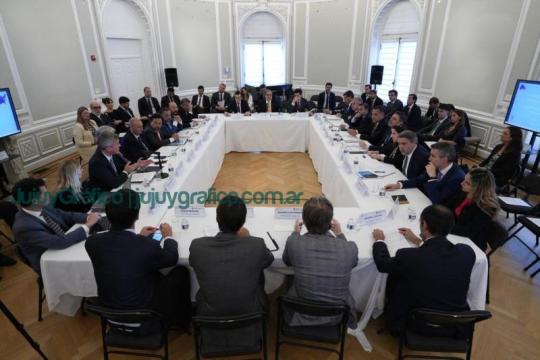
View On WordPress
#Atlantic Council#Banco Interamericano de Desarrollo#Banco Mundial#BID#BM#Catamarca#CFI#Chaco#Consejo Federal de Inversiones#Council of Americas#Eduardo De Pedro#Embajada Argentina#Estados Unidos#Eurasia Group#Formosa#Fundación IRI#Fundación NDI#Gerardo Morales#Gerardo Zamora#Gildo Insfrán#Gustavo Sáenz#Ignacio Lamothe#Inter-American Dialogue#Jorge Capitanich#Jorge Martín Arturo Argüello#Jujuy#La Rioja#Misiones#Norte Grande#Nueva York
0 notes
Text



Access Denied: The Inaccessible Island Rail
The Inaccessible Island rail (Laterallus rogersi) is a rarely seen member of the rail family, Rallidae. Part of the reason for its obscurity is the place in which it resides: Inaccessible Island, part of the Tristan da Cunha archipelago in the southern Atlantic Ocean. These islands are extremely remote, and until 2019 it was unclear how L. rogersi even came to be there. We now know that the species colonized the island some 1.5 million years ago, originally coming in from South America and subsequently losing its ability to fly.
In addition to its unique evolutionary history, the Inaccessible Island rail's greatest claim is that it is the smallest flightless bird in the world. Individuals weigh between 35 to 49 g (1.2–1.7 oz) and can be 13 to 15.5 cm (5.1–6.1 in) long from beak to tail. Members of both sexes are dark brown with red eyes; some may have white striping along the underbelly or wings. Females tend to be slightly smaller and lighter in color than males.
The Inaccesible Island rail can be found on all habitats on the island in which it inhabits; these include low mountains and fern brush though the species is most abundant in the grasslands that grow close to the rocky shore. Within these habitats, L. rogersi is largely diurnal. They freely forage for invertebrates, including earthworms, beetles, and moths, as well as seeds and berries; as they have no natural predators they have few defenses against potential threats, although they can run extremely fast when alarmed.
Adults are highly territorial, and when two rivals of either sex encounter each other they will display by lowering their heads, circling each other, and calling loudly until one of them concedes. Males and females mate for life, and build nests in the tall grass. The breeding season is between October and January, in late summer, and females lay a clutch of 2 eggs. Both parents take turns incubating the eggs until they hatch. Chicks can be vulnerable to predation by the migratory brown skua, so parents guard the nest fiercely. The time it takes for chicks to fully mature is unknown, as is the average lifespan in the wild.
Conservation status: The Inaccessible Island rail is considered Vulnerable by the IUCN. The island's population is believed to stand at about 5,600 adult birds. While the island's ecology is currently stable, researchers believe the species would be seriously imperaled if invasive species such as house mice, feral cats and brown rats were introduced. Access to the island is currently restricted, and the island has been declared a nature reserve by the Tristan da Cunha Island Council.
If you like what I do, consider leaving a tip or buying me a kofi!
Photos
Peter G. Ryan
#inaccessible island rail#Gruiformes#Rallidae#rails#birds#islands#island birds#grasslands#grassland birds#Atlantic ocean#animal facts#biology#zoology
939 notes
·
View notes
Text
In Costa Rica and Latvia today, the Atlantic Council is hosting its 360/OS Summit at RightsCon Costa Rica and NATO’s Riga StratCom. Among other things, the influential think tank will be previewing its “Task Force for a Trustworthy Future Web” report, which they hope will “lay the groundwork for stronger cross-sectoral ideation and action” and “facilitate collaboration now between the expanding community dedicated to understanding and protecting trust and safety.”
In human terms, conference attendees are discussing how best to stay on-brand by presenting the Censorship-Industrial Complex as a human rights initiative, and as #TwitterFiles documents show, they have the juice to pull it off.
EngageMedia (which I co-founded and was the long-time Executive Director) co-organized RightsCon in Manila in 2015, and I personally oversaw a lot of the preparations. That looks like a big mistake. I now believe RightsCon represents everything that has gone wrong in the digital rights field. Specifically, it represents the capture of a once-vibrant movement by corporate and government interests, and a broader shift towards anti-liberal and authoritarian solutions to online challenges. I left EngageMedia on good terms, but now have no formal relationship.
In honor of this week’s RightsCon and 360/OS Summit, we dug into the #TwitterFiles to revisit the integration of the Atlantic Council’s anti-disinformation arm, the Digital Forensic Research Labs (DFRLab), while also highlighting its relationship with weapons manufacturers, Big Oil, Big Tech, and others who fund the NATO-aligned think tank.
The Atlantic Council is unique among “non-governmental” organizations thanks to its lavish support from governments and the energy, finance, and weapons sectors. It’s been a key player in the development of the “anti-disinformation” sector from the beginning. It wasn’t an accident when its DFRLab was chosen in 2018 to help Facebook “monitor for misinformation and foreign interference,” after the platform came under intense congressional scrutiny as a supposed unwitting participant in a Russian influence campaign. Press uniformly described DFRLab as an independent actor that would merely “improve security,” and it was left to media watchdog FAIR to point out that the Council was and is “dead center in what former President Obama’s deputy national security advisor Ben Rhodes called ‘the blob.’”
What’s “the blob”? FAIR described it as “Washington’s bipartisan foreign-policy consensus,” but thanks to the Twitter Files, we can give a more comprehensive portrait. In the runup to the 360/OS event in that same year, 2018, Graham Brookie of the Atlantic Council boasted to Twitter executives that the attendees would include the crème de la crème of international influence, people he explained resided at the “no-kidding decision-maker level”:

Similar correspondence to and from DFRLab and Twitter outlined early efforts to bring together as partners groups that traditionally served as watchdogs of one another. Perhaps more even than the World Economic Forum meetings at Davos or gatherings of the Aspen Institute in the US, the Atlantic Council 360/OS confabs are as expansive a portrait of the Censorship-Industrial Complex as we’ve found collected in one place.
In October 2018, DFRLab was instrumental in helping Facebook identify accounts for what became known as “the purge,” a first set of deletions of sites accused of “coordinated inauthentic behavior.” Facebook in its announcement of these removals said it was taking steps against accounts created to “stir up political debate,” and the October 2018 “purge” indeed included the likes of Punk Rock Libertarians, Cop Block, and Right Wing News, among others. Even the progressive Reverb Press, founded by a relatively mainstream progressive named James Reader, found his site zapped after years of pouring thousands of dollars a month into Facebook marketing tools. “That’s what sticks in my craw. We tried to do everything they suggested,” Reader said then. “But now, everything I worked for all those years is dead.”
In the years since, DFRLab has become the central coordination node in the Censorship Industrial Complex as well as a key protagonist in the Election Integrity Partnership and the Virality Project. Its high-profile role at RightsCon, the biggest civil society digital rights event on the calendar, should concern human rights and free expression activists.
According to their London 2019 event “360/OS brings together journalists, activists, innovators, and leaders from around the world as part of our grassroots digital solidarity movement fighting for objective truth as a foundation of democracy.” Their Digital Sherlocks program aims to “identify, expose, and explain disinformation.” But DRFLabs are more Inspector Gadget (or double agents) than Sherlock Holmes. The Twitter Files reveal DFRLab labeled as “disinformation” content that often turned out to be correct, that they participated in disinformation campaigns and the suppression of “true” information, and that they lead the coordination of a host of actors who do the same.
Twitter Files #17 showed how DFRLab sent Twitter more than 40,000 names of alleged BJP (India’s ruling nationalist party) accounts that they suggested be taken down. DFRLab said it suspected these were “paid employees or possibly volunteers.” However as Racket’s Matt Taibbi noted, “the list was full of ordinary Americans, many with no connection to India and no clue about Indian politics.” Twitter recognized there was little illegitimate about them, resulting in DFRLab pulling the project and cutting ties with the researcher.
Twitter Files #19 further revealed DFRLab was a core partner in the Election Integrity Partnership (EIP), which “came together in June of 2020 at the encouragement of the U.S. Department of Homeland Security’s Cybersecurity and Infrastructure Security Agency, or CISA” in order to “fill the gaps legally” that government couldn’t. As a result, there are serious questions as to whether the EIP violated the US First Amendment.
DFRLab was also a core partner on the Virality Project, which pushed its seven Big Tech partners to censor “stories of true vaccine side-effects.” The Stanford Internet Observatory, which led the project, is now being sued by the New Civil Liberties Alliance for its censorship of “online support groups catering to those injured by Covid vaccines.” Debate as to the frequency of serious adverse events is ongoing, however. The German health minister put it at 1 in 10,000, while others claim it is higher.
The Virality Project sought to suppress any public safety signals at all. The Stanford Internet Observatory is also at the moment reportedly resisting a House Judiciary Committee subpoena into its activities.
TwitterFiles #20 revealed some of the Digital Forensic Lab’s 2018 360/0S events, which brought together military leaders, human rights organizations, the Huffington Post, Facebook and Twitter, Edelman (the world’s biggest PR firm), the head of the Munich Security Conference, the head of the World Economic Forum (Borge Brende) a former President, Prime Minister and CIA head, intel front BellingCat and future Nobel Peace Prize winner Maria Ressa, all to combat “disinformation.” We can now reveal more.
Introducing the Atlantic Council

The Atlantic Council is a NATO-aligned think tank established in 1961. Its board of directors and advisory board are a Who’s Who of corporate, intelligence and military power, including:
James Clapper – former Director of National Intelligence whose tenure included overseeing the NSA during the time of the Snowden leaks. Asked whether intelligence officials collect data on Americans Clapper responded “No, sir,” and, “Not wittingly.” Clapper also coordinated intelligence community activity through the early stages of Russiagate, and his office authored a key January 2017 report concluding that Russians interfered in 2016 to help Donald Trump. Clapper has been a 360/OS attendee.
Stephen Hadley, United States National Security Advisor from 2005 to 2009 (also a 360/OS attendee)
Henry Kissinger, former US Secretary of State who oversaw the carpet bombing of Vietnam, among other crimes against humanity
Pfizer CEO Anthony Bourla
Stephen A. Schwarzman, Chairman, CEO, and Co-Founder, The Blackstone Group
Meta’s President for Global Affairs, Nick Clegg
Richard Edelman, CEO of the world’s largest PR firm (and 360/OS attendee)
The Rt. Hon. Lord Robertson of Port Ellen, Former Secretary General of NATO
Ambassador Robert B. Zoellick, Former President of the World Bank
Leon Panetta, former US Secretary of Defense & CIA Director. Panetta oversaw the US’s massive growth in drone strikes.
John F. W. Rogers. Goldman Sachs Secretary of the Board
Chuck Hagel, chairman of the Council, sits on the board of Chevron and is also a former US Secretary of Defence.
The Atlantic Council raised $70 million in 2022, $25 million of which came from corporate interests. Among the biggest donors were: the US Departments of Defense State, Goldman Sachs, the Rockefeller Foundation, Craigslist founder Craig Newmark, Google, Crescent Petroleum, Chevron, Lockheed Martin, General Atomics, Meta, Blackstone, Apple, BP, eBay founder Pierre Omidyar, Raytheon, ExxonMobil, Shell, Twitter, and many more. Ukraine’s scandal-ridden energy company, Burisma, whose links to Hunter Biden were suppressed by the August 2020 table-top exercise coordinated by the Aspen Institute, also made a contribution. You can view the full 2022 “honor roll” by clicking here.
The Atlantic Council is the Establishment, though many suffer from the delusion that in putting on a “Digital Sherlock” cape, they’re somehow with the rebel alliance. The opposite is true. The Atlantic Council and DFRLab don’t hide their militarist affiliations. This week’s OS/360 event at RightsCon Costa Rica runs together with a 360/OS at NATO’s Riga StratCom Dialogue, which DFRLab note they have “worked closely with” “since 2016.”
The Birth of the Digital Forensic Research Lab
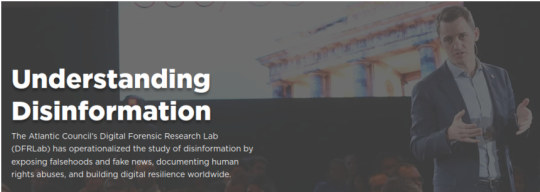
DFRLab was founded in 2016, and has been a major catalyst in expanding the “anti-disinformation” industry. Among non-governmental entities, perhaps only the Aspen Institute comes close to matching the scope, scale and funding power of DFRLab. DFRLab claims to chart “the evolution of disinformation and other online and technological harms, especially as they relate to the DFRLab’s leadership role in establishing shared definitions, frameworks, and mitigation practices.”
Almost $7 million of the Atlantic Council’s $61 million spent last year went to the DRFLabs, according to their 2022 annual financial report. Through its fellowship program, it has incubated leading figures in the “disinformation” field. Richard Stengel, the first director of the Global Engagement Center (GEC), was a fellow. GEC is an interagency group “within” the State Department (also a funder of the Atlantic Council), whose initial partners included the FBI, DHS, NSA, CIA, DARPA, Special Operations Command (SOCOM), and others. GEC is now a major funder of DFRLab and a frequent partner:
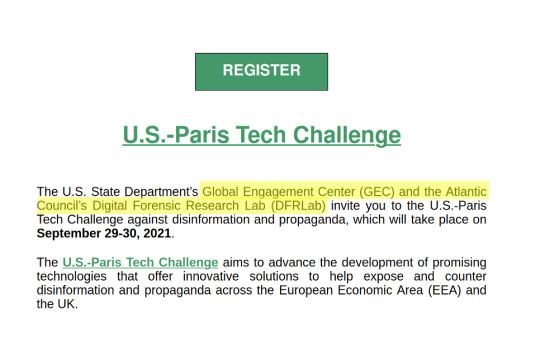
In this video, Stengel says, “I’m not against propaganda. Every country does it, they have to do it to their own population, and I don’t think it’s that awful.”
Stengel was true to his word, and apart from DFRLab, the GEC funded the Global Disinformation Index, which set out to demonetize conservative media outlets it claimed were “disinformation.” (See 37. in the censorship list) He thought the now-disgraced Hamilton68 was “fantastic.” In total, GEC funded 39 organizations in 2017. Despite Freedom of Information requests, only 3 have been made public to date. Roughly $78 million of GEC’s initial $100 million budget outlay for fiscal year 2017 came from the Pentagon, though the budgetary burden has shifted more toward the State Department in the years since.
The Global Engagement Center was established in the last year of Barack Obama’s presidency, via a combination of an executive order and a bipartisan congressional appropriation, led by Ohio Republican Rob Portman and Connecticut Democrat Chris Murphy. The GEC was and remains virtually unknown, but reporting in the Twitter Files and by outlets like the Washington Examiner have revealed it to be a significant financial and logistical supporter of “anti-disinformation” causes.
Though tasked by Obama with countering “foreign state and non-state propaganda and disinformation efforts aimed at undermining United States national security interests,” its money has repeatedly worked its way back in the direction of policing domestic content, with Gabe Kaminsky’s Examiner reports on the GDI providing the most graphic example.
GEC frequently sent lists of “disinformation agents to Twitter.” Yoel Roth, former head of Trust and Safety referred to one list as a “total crock.” Roth is now a member of DFRLab’s Task Force for a Trustworthy Future Web. Let’s hope he brings more trust than Stengel. You can read more on GEC’s funding here.
Other DFRLab luminaries include Simon Clark, Chairman of the Center for Countering Digital Hate (a UK “anti-disinformation” outfit that aggressively deplatforms dissidents), Ben Nimmo (previously a NATO press officer, then of Graphika (EIP and the Virality Project partners) and now Facebook’s Global Threat Intelligence Lead), and Eliot Higgins of Bellingcat. Bellingcat has an ominous reputation, which it’s earned in numerous ways, including its funding by the National Endowment for Democracy (see Glenn Greenwald’s recent report and Aaron Maté’s here). Most recently, Bellingcat assisted in the arrest of the 21-year-old Pentagon leaker, further speeding up the abandonment of the Pentagon Papers Principal where the media protected, rather than persecuted, leakers. Bellingcat was part of 360/OS backroom meetings with former intel chiefs, the head of Davos and the Munich security conference among many others, as we will see soon.
As noted in the introduction, DFRLab itself has made several wrong calls on “disinformation.” In one report they highlighted “outright false narratives,” which focused mainly on the notion that Covid was an engineered bioweapon, but lumped in the “unverified” claim Covid was the “result of a lab accident.” A lab accident is now the preferred hypothesis of the US Department of Energy, the FBI, and many others. To the DFRLab it was “disinformation” and a “conspiracy theory.”
The Election Integrity Partnership and the Virality Project
DFRLab were core partners on two of the most influential “anti-disinformation” initiatives of recent times.
The Virality Project built on the EIP and had partnerships with Twitter, Facebook, Instagram, Youtube, Google, TikTok and more to combat vaccine “misinformation.” Stanford and DFRLab partnered with the University of Washington’s Center for an Informed Public, Graphika, NYU Tandon School of Engineering and Center for Social Media and Politics, and the National Congress on Citizenship. Through a shared Jira ticketing system they connected these Big Tech platforms together, with Graphika using sophisticated AI to surveil the online conversation at scale in order to catch “misinformation” troublemakers.
VP went far beyond any kind of misinformation remit, most infamously recommending to their Big Tech partners that they consider “true stories of vaccine side effects” as “standard misinformation on your platform.”

A Virality Project partner called the Algorithmic Transparency Initiative (a project of the National Congress on Citizenship) went further. Their Junkipedia initiative sought to address “problematic content” via the “automated collection of data” from “closed messaging apps,” and by building a Stasi-like “civic listening corps,” which in recent years has taken on a truly sinister-sounding mission. The current incarnation might as well be called “SnitchCorps,” as “volunteers have an opportunity to join a guided monitoring shift to actively participate in monitoring topics that disrupt communities”:
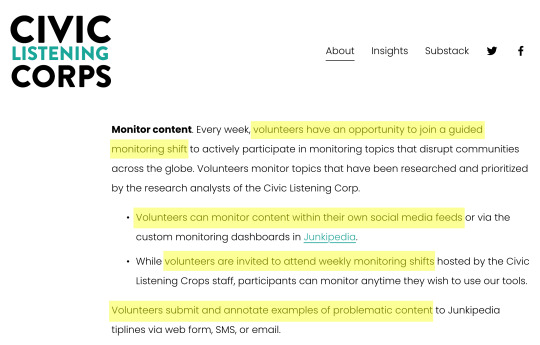
Garret Graff, who oversaw the Aspen Hunter Biden table-top exercise, was chairman of that same National Congress on Citizenship when they collaborated on the Virality Project. Both EIP and VP were led by Renee DiResta of the Stanford Internet Observatory, a former CIA fellow who engineered the now disgraced New Knowledge initiative, which developed fake Russian bots to discredit a 2016 Alabama senate race candidate, as acknowledged by the Washington Post. You can read Racket’s previous work on the Virality Project here.
DFRLab are the elite of the “anti-disinformation” elite. They work closely with a wide range of actors who have participated in actual disinformation initiatives. Here they’re invited to an elite Twitter group set up by Nick Pickles of “anti-disinformation” luminaries First Draft, also participants in the Hunter Biden laptop tabletop, and the Alliance for Security Democracy, part of the RussiaGate Hamilton68 disinformation operation.

360/OS
The 360/OS event marries this tarnished record with the financial, political, military, NGO, academic and intelligence elite. Some of this is visible through publicly available materials. Twitter Files however reveal the behind the scenes, including closed door, off-the-record meetings.
“I’ve just arrived in Kyiv” Brookie notes in 2017, as he seeks to line up a meeting with Public Policy Director Nick Pickles as they discuss Twitter providing a USD $150K contribution to OS/360 (seemingly secured), and to garner high level Twitter participation.
Pickles is visiting DC and Brookie suggests he also meet with the GEC and former FBI agent Clint Watts of Hamilton 68 renown. “Happy to make those connections,” he chimes.

360/OS events are elite and expensive — $1 million according to Brookie — so closer collaboration with Twitter, especially in the form of funding, is a high priority.

Twitter offers $150,000:
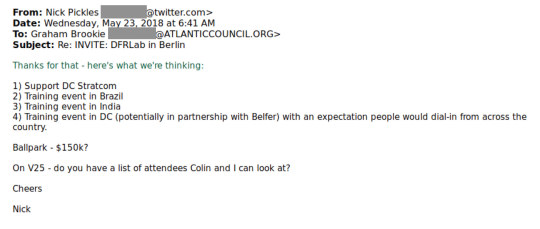
When Brookie mentions the attendees at the “no-kidding decision maker level” he isn’t kidding. Parallel to the 360/OS public program is the much more important off-the-record meeting of “decision makers ranging from the C-Suite to the Situation Room.” Here, he is explicit about a convening of military and financial power. Vanguard 25 is presented as a way to “create a discreet and honest way to close the information gap on challenges like disinformation between key decision makers from government, tech, and media.”

The document boasts of its high-level participants:

More are revealed in email exchanges, including Madeleine Albright and the head of the WEF:

They go on to list a bizarre mishmash of media leaders, intelligence officials, and current or former heads of state:

It appears Germany’s Angela Merkel was out of reach in the end, but many of the others attended this behind the scenes meeting on “disinformation.” Who are they?
Matthias Dopfner – CEO and 22% owner of German media empire Axel Springer SE, the biggest media publishing firm in Europe
Borge Brende – head of the World Economic Forum and former Norwegian foreign minister
Toomas Hendrick Ilves – former President of Estonia who co-chairs the World Economic Forum’s Global Futures Council on Blockchain Technology. Hendrick is also a fellow at the Freeman Spogli Institute for International Studies (where the Stanford Internet Observatory is housed) and is on the advisory council of the Alliance for Securing Democracy, of Hamilton 68 renown.
Chris Sacca – billionaire venture capitalist
Mounir Mahjoubi – previously Digital Manager for President Macron’s presidential campaign, and former Chairman of the French Digital Council
Reid Hoffman – billionaire and Linkedin co-founder
Ev Williams – Former CEO of Twitter and on the Twitter board at the time
Kara Swisher – New York Times opinion writer, who founded Vox Media Recode
Wolfgang Ischinger - Head of the Munich Security Conference
Aleksander Kwasniewski – Former President of Poland. Led Poland into NATO and the EU.
Richard Edelman – CEO of the largest PR company in the world
Elliot Shrage – previously Vice-President of Public Policy at Facebook (DFRLab had election integrity projects with Facebook)
Lydia Polgreen – Huffington Post Editor in Chief
Jim Clapper – former US Director of National Intelligence
Maria Ressa – co-founder of Rappler and soon to be winner of the Nobel Peace Prize
JK Rowling was also invited to give an award, though appears she didn’t make it in the end:

Why would such a group all gather specifically around the question of “disinformation”? Is disinformation truly at such a level that it requires bringing together the world’s most popular author with military and intelligence leaders, the world’s biggest PR company, journalists, billionaires, Big Tech and more? Or is this work to build the case that there is a disinformation crisis, to then justify the creation of a massive infrastructure for censorship? A glimpse of the agenda offers clues:

Here the head of the most important military and intelligence conference in the world (Munich) sits down in a closed door meeting with a former Secretary of State and the Executive Vice-Chair of the Atlantic Council.

Which is followed by a closed door session with the Editor-in Chief of the now-defunct Huffington Post and peace-maker Maria Ressa who presented to the same group of military, intelligence, corporate and other elites. Is the role of a journalist and Nobel laureate to work behind closed doors with militarists and billionaires, or to hold them to account?
At 2022’s OS/360 at RightsCon Ressa conducted a softball interview on disinformation with current US Secretary of State Anthony Blinken. In testimony last April 2023, former CIA deputy director Michael Morrell stated that Blinken “set in motion the events that led to the issuance of the public statement” by more than 50 former intelligence officials that the Hunter Biden laptop had “all the classic earmarks of a Russia information operation.”
The Twitter Files also revealed that in August 2020 the Aspen Institute organized a table-top exercise to practice how best to respond to a “hack and leak” of a Hunter Biden laptop. The laptop only came to light however two months later. In attendance was First Draft (now the Information Futures Lab), the New York Times, Washington Post, Rolling Stone, CNN, Yahoo! News, Facebook, Twitter and more. Here, DFRLab head Graham Brookie speaks with the Aspen Institute’s Garret Graff, who coordinated the Hunter Biden tabletop exercise.
After it turned out the Hunter Biden laptop was real, and the disinformation operation was more appropriately described as having been led by the likes of Blinken and the Aspen Institute. The appropriate response is apparently for RightsCon, DFRLab, Blinken and Ressa to put on a nice forum to promote these figures as “anti-disinformation” leaders.
youtube
Former DFRLab fellow and intel front Bellingcat founder Eliot Higgins is also invited to the closed door sessions with a former head of the CIA, a former Prime Minister and a President. How do you keep power accountable when you are in the same cozy club? This theme runs throughout. Bellingcat is featured heavily at the public sessions also:
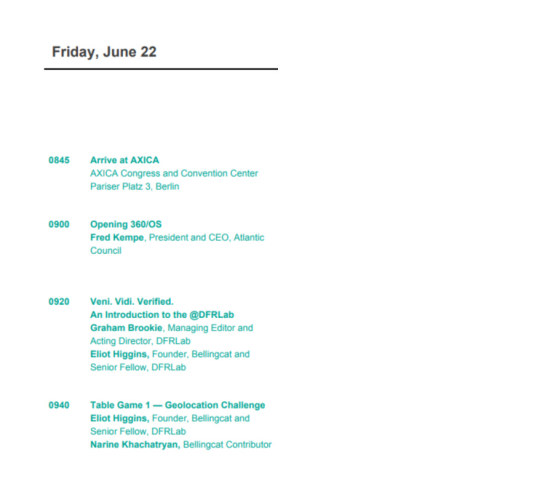
Higgins has a unique way of expressing himself online, given the DFRLab emphasis on striking out against divisiveness:
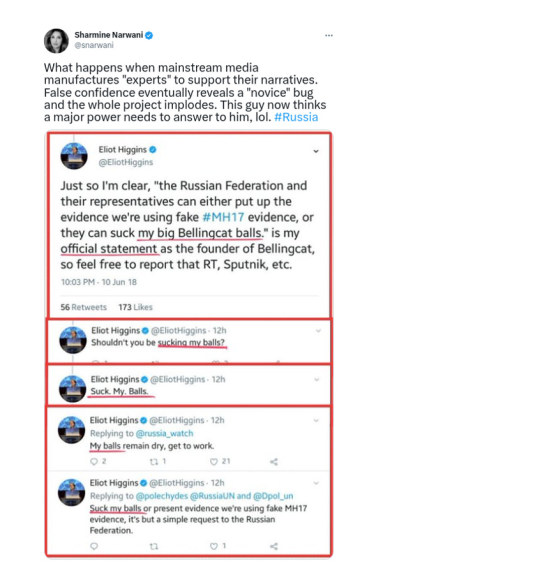
Would this pass RightsCon’s code of conduct? If not, he appears to be good enough for DFRLab to promote.
On the public side, we see Amnesty International participating to further collapse the distinction between those who are meant to hold power to account, and the powerful themselves. The Iraq war gave us embedded journalists, and the “anti-disinformation” field gives us embedded digital rights activists.

The Department of Homeland Security’s Chris Krebs also joined the closed door session. Krebs was Co-Chair of the Aspen Institute’s Commission on Information Disorder. Other members included Prince Harry, the Virality Project’s Alex Stamos (Stanford Internet Observatory) and Kate Starbird (University of Washington and previous 360/OS participant), Katie Couric, and more. Craig Newmark attended as an observer.
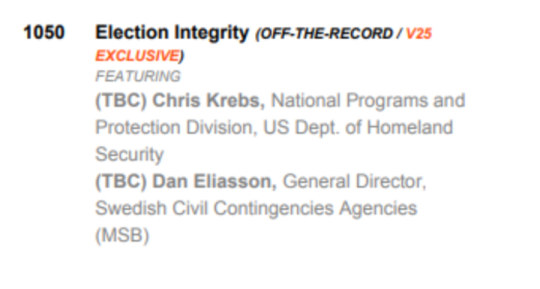
Meanwhile Renee DiResta, former CIA fellow and Stanford Internet Observatory Research Director, presented with the former Prime Minister of Sweden. This was years before she would launch the Virality Project, and take on the bugbear of “true stories of vaccine side effects.”

The President of the Atlantic Council participated in an “off-the-record, “ behind closed doors conversation on “trust” with the CEO of the world’s biggest PR firm, Edelman.
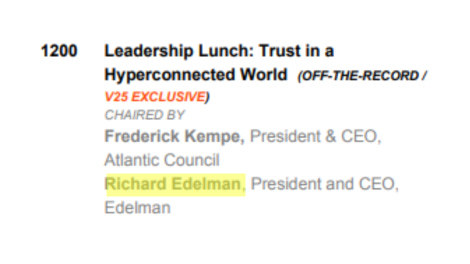
“Public relations” and “trust” may well be opposites, and trust is being destroyed not by the disinformation street crime that these groups claim to target, but by the disinformation corporate crime protected by, or in some cases created by these same people. Disinformation is real, but its biggest purveyors are governments and powerful corporate interests.
DFRLab and RightsCon show just how far the capture of civil society by elite interests has come. Again, I made a mistake helping to co-organize RightsCon in 2015. The jumping in bed with the government and Big Tech was arguably there in 2015, though to a much lesser degree. It now partners with militarists in the form of the Atlantic Council and is an enabler of the “disinformation” grift that is so deeply impacting freedom of speech and expression.
The air-gaps that should separate civil society, media, military, billionaires, intelligence and government have collapsed, and many of these actors have formed a new alliance to advance their shared interests. If weapons manufacturers funding human rights is considered legitimate then where is the red line? Effectively, there is none.
This collapse however has also been pushed by funders, who have been proactive in asking NGOs to collaborate more with Big Tech and government - something I successfully resisted for my almost 18 years at EngageMedia, critically RightsCon was the only time I let my guard down.
The RightsCon sponsor matrix wouldn’t be out of place at NASCAR:

This is the equivalent of hosting a Climate Change conference sponsored by Shell, BP, Chevron, and ExxonMobil. How do you keep power accountable when Big Tech pays your wage? The “let’s all work together” approach has failed. The weakest partner, civil society, got captured and we lost. Many more lost their way and have acquiesced to and often enabled much of the new censorship regime.
A renewed and much more independent digital rights movement, with a strong commitment to freedom of expression, is well overdue.
Note: A previous version of this article mistook Blackstone for Blackwater. This has been corrected.
#rightscon#360/OS#twitter#twitter files#censorship#digital censorship#internet censorship#censorship industrial complex#atlantic council#DFRLAB#covid vaccines#virality project#NATO#propaganda#global engagement center#bellingcat#civic listening corps#world economic forum#stanford internet observatory#big tech#hunter biden#aspen institute#amnesty international#Youtube
2 notes
·
View notes
Text
في إطار حرب أوكرانيا.. ما الخطوة التالية لبوتين؟
في إطار حرب أوكرانيا.. ما الخطوة التالية لبوتين؟
في إطار حرب أوكرانيا.. ما الخطوة التالية لبوتين؟
في إطار حرب أوكرانيا.. ما الخطوة التالية لبوتين؟
الجزيرة
يستعرض هارلان أولمان كبير مستشاري “المجلس الأطلسي” (Atlantic Council) المزايا الإستراتيجية والاقتصادية والتكتيكية والعسكرية المحتملة التي قد يراها الرئيس الروسي فلاديمير بوتين والتي تساعد على استنتاج الخطوة التالية المحتملة منه في إطار حرب أوكرانيا.
ويحدد أولمان في مقال له بموقع “ذا هيل”…

View On WordPress
0 notes
Text
في إطار حرب أوكرانيا.. ما الخطوة التالية لبوتين؟
في إطار حرب أوكرانيا.. ما الخطوة التالية لبوتين؟
في إطار حرب أوكرانيا.. ما الخطوة التالية لبوتين؟
في إطار حرب أوكرانيا.. ما الخطوة التالية لبوتين؟
الجزيرة
يستعرض هارلان أولمان كبير مستشاري “المجلس الأطلسي” (Atlantic Council) المزايا الإستراتيجية والاقتصادية والتكتيكية والعسكرية المحتملة التي قد يراها الرئيس الروسي فلاديمير بوتين والتي تساعد على استنتاج الخطوة التالية المحتملة منه في إطار حرب أوكرانيا.
ويحدد أولمان في مقال له بموقع “ذا هيل”…

View On WordPress
0 notes
Text
The EU Doesn’t Know How to Not Be a Vassal of the US Anymore
Former Fox News host Tucker Carlson has tried to show Americans how Washington has exploited Western Europe
— Bradley Blankenship | RT | August 22, 2023

(From L to R) US President Joe Biden, Germany's Chancellor Olaf Scholz, Britain's Prime Minister Rishi Sunak and European Commission President Ursula von der Leyen at the G7 Leaders' Summit in Hiroshima on May 19, 2023 © Kenny Holston/POOL/AFP
Tucker Carlson, of Fox News fame, recently met with Serbia’s President Aleksandar Vucic in Budapest, Hungary. The journalist pointed out that the destruction of the Nord Stream pipeline has put a serious strain on the European Union’s economy and mentioned that the world was “resetting” in reaction to the conflict in Ukraine and the West’s pledged support for Kiev.
Carlson raises some good issues, and an important one to expand upon is the fact that the EU economy is lagging significantly since the outbreak of the war last year. A June piece by the Financial Times titled ‘Europe has fallen behind America and the gap is growing’ details how the EU is now considerably dependent on the US for its technological, security, and economic needs.
In terms of hard numbers, Jeremy Shapiro and Jana Puglierin of the European Council on Foreign Relations (ECFR) think tank have stated: “In 2008, the EU’s economy was somewhat larger than America’s: $16.2tn versus $14.7tn. By 2022, the US economy had grown to $25tn, whereas the EU and the UK together had only reached $19.8tn. America’s economy is now nearly one-third bigger. It is more than 50 per cent larger than the EU without the UK.”
The article goes on to describe a European Union that is dragging far behind the US and China in terms of quality universities, a less-than-pristine start-up environment, and lacking key benefits from its transatlantic peer – namely cheap energy. The Ukraine conflict has impacted the latter to the point that EU companies are paying three or four times what their American competitors are, with Washington being energy-independent and enjoying great domestic supplies. Meanwhile, energy from Russia is waning, European factories are closing in droves, and industry leaders are worried about the region’s future competitiveness.
The ECFR issued its own report on the matter in April, which is far blunter in describing the situation as a kind of “vassalization.” The summary of that report notes that the Ukraine war has exposed the EU’s key dependencies on the US, that over the course of a decade, the bloc has fallen behind the US in virtually every key metric, that it is deadlocked in disagreement and is looking to Washington for leadership.
The ECFR noted two causes for this situation. Firstly, despite the widely understood decline of the US compared to the rise of China, the transatlantic relationship has been unbalanced in Washington’s favor over the last 15 years since the 2008 financial crisis. The Biden administration is keen to exploit this and assert itself in the face of a disjointed Europe. Secondly, no one in the EU knows what greater strategic autonomy could look like – let alone agree on it if they did. There exists no process to decide the EU’s future in an autonomous way given the current status quo, which means US leadership is necessary.
This paints quite an interesting picture. Many commentators, including myself, have long documented the decline of the US and attributed it to a number of factors: less of an attractive environment for foreign direct investment (FDI), financial instability, corruption, and internal political turmoil. This is, of course, relativized to China, which has seen immense economic growth since the founding of the People’s Republic and particularly over the past four decades. But under the smoke screen of a fumbling America and a growing China, the EU has likewise fallen in stature.

The Western Establishment just gave itself a ‘World Peace and Liberty’ Award! Ursula von der Leyen received the ‘Judicial Equivalent’. The Western Establishment just gave itself a ‘World Peace and Liberty’ Award. Ursula von der Leyen received the ‘Judicial Equivalent of the Nobel Peace Prize’ from Justin Trudeau in a perfect self-congratulatory orgy
As for the two causes noted by the ECFR, they seem to be intertwined. Many of the key issues that have faced the EU, from migration to the banking crisis to Covid-19, have stemmed directly from the non-federal nature of the EU. And the current political crises are a result of Euroskepticism, i.e. a backlash against what is perceived as an overreach from Brussels by some political organizations within the bloc. The EU is a complicated and sometimes cumbersome bureaucracy that is cherished by some, reviled by others, and, under these assumptions, is an impediment to strategic autonomy.
The ECFR essentially argues for the EU and Western European capitals to lean into the transatlantic partnership, but on terms favorable to themselves. This includes creating an independent security architecture within and complimentary to NATO, creating an economic NATO of sorts and even pursuing a European nuclear weapons program. At least the former two are acceptable, as abandoning the US outright would be politically foolish for the EU at this juncture. It certainly needs to develop a transatlantic free-trade agreement that puts an end to American trade protectionism.
However, the obvious point to help diversify the Western European economic portfolio, reduce genuinely problematic dependencies, and fuel growth is for the EU to develop peer-to-peer relations with the Global South. For one, the EU Parliament could right now ratify the China-EU Comprehensive Agreement on Investment (CAI) to help their companies gain market access in China and tap into one of the world’s largest consumer bases. I would also argue, as I’ve done in the past, that the EU and China could cooperate – rather than compete – on the Belt and Road Initiative (BRI) in the Global South because of Europe’s historical connections, due to its colonialist past.
What is clear is that the EU needs to diversify and back off from the transatlantic relationship. With much talk about ‘de-risking’, or even ‘de-coupling’, from China, Western Europe has actually gotten into the position where it is strategically dependent on Washington to the point of being outright vassalized. This is a bleak situation for the EU’s growth model and its hopes for strategic autonomy.
— Bradley Blankenship is an American Journalist, Columnist and Political Commentator. He has a syndicated column at CGTN and is a freelance reporter for international news agencies.
#European Union 🇪🇺#United States 🇺🇸#Bradley Blankenship#Tucker Carlson#Western Europe#Serbia’s 🇷🇸 President Aleksandar Vucic | Budapest#Ukraine 🇺🇦#Financial Times#Jeremy Shapiro | Jana Puglierin#European Council on Foreign Relations (ECFR)#UK 🇬🇧#China 🇨🇳#Foreign Direct Investment (FDI)#Ursula von der Leyen#Euroskepticism#North Atlantic Terrorist Organization (NATO)#Belt and Road Initiative (BRI)#China-EU Comprehensive Agreement
3 notes
·
View notes
Text
في إطار حرب أوكرانيا.. ما الخطوة التالية لبوتين؟
في إطار حرب أوكرانيا.. ما الخطوة التالية لبوتين؟
في إطار حرب أوكرانيا.. ما الخطوة التالية لبوتين؟
في إطار حرب أوكرانيا.. ما الخطوة التالية لبوتين؟
الجزيرة
يستعرض هارلان أولمان كبير مستشاري “المجلس الأطلسي” (Atlantic Council) المزايا الإستراتيجية والاقتصادية والتكتيكية والعسكرية المحتملة التي قد يراها الرئيس الروسي فلاديمير بوتين والتي تساعد على استنتاج الخطوة التالية المحتملة منه في إطار حرب أوكرانيا.
ويحدد أولمان في مقال له بموقع “ذا هيل”…
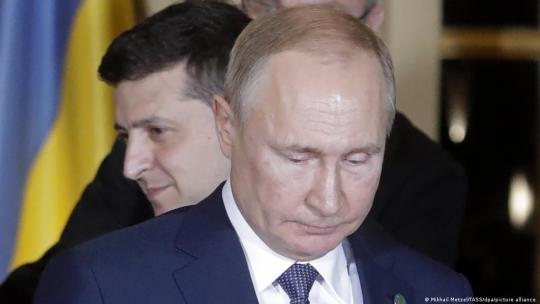
View On WordPress
0 notes
Photo
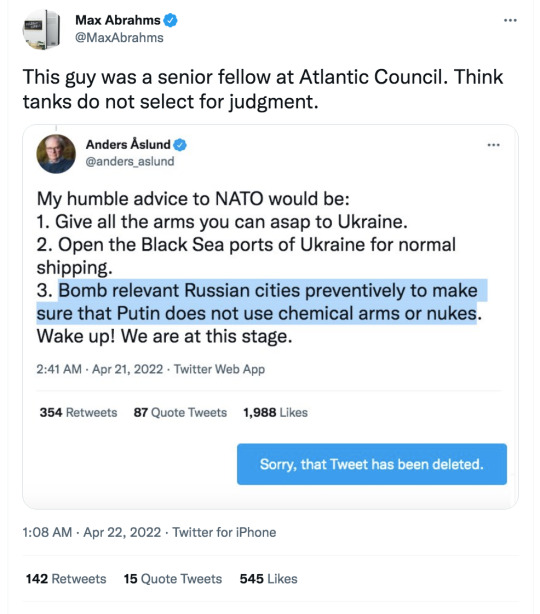
(link)
0 notes
Text
Toronto city council voted Thursday to rename Yonge-Dundas Square to Sankofa Square and recommended a host of other landmarks be stripped of the Dundas name over connections to the trans-Atlantic slave trade.
The move comes more than three years after council first received a petition raising concerns about the name at the height of the Black Lives Matter protests sparked by the police killing of George Floyd in the United States.
In a late council session Thursday night, councillors voted 19-2 to rename Yonge-Dundas Square. Coun. Jaye Robinson, who represents Ward 15, and Coun. Stephen Holyday, who represents Ward 2, voted against the move.
Continue Reading
Tagging @politicsofcanada
#cdnpoli#canada#canadian politics#canadian news#toronto#ontario#black lives matter#landmark renaming
194 notes
·
View notes